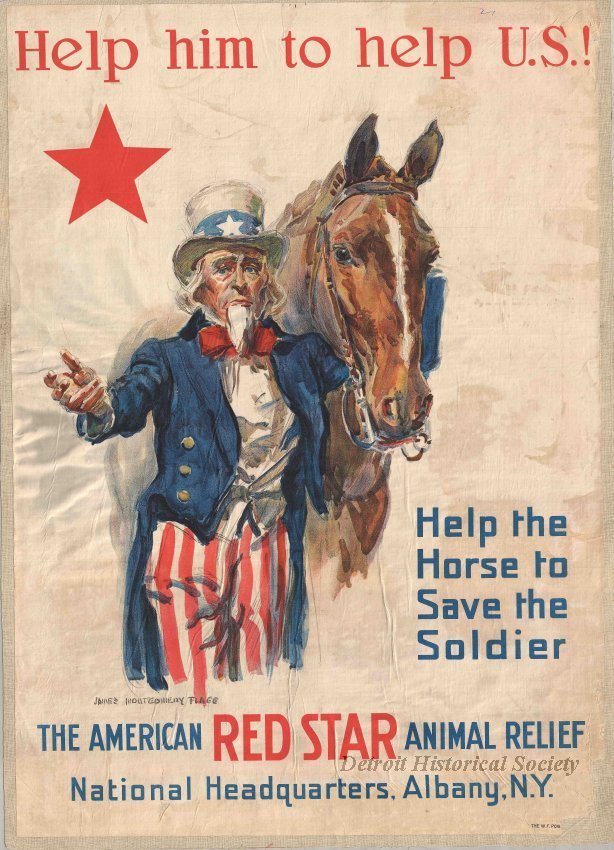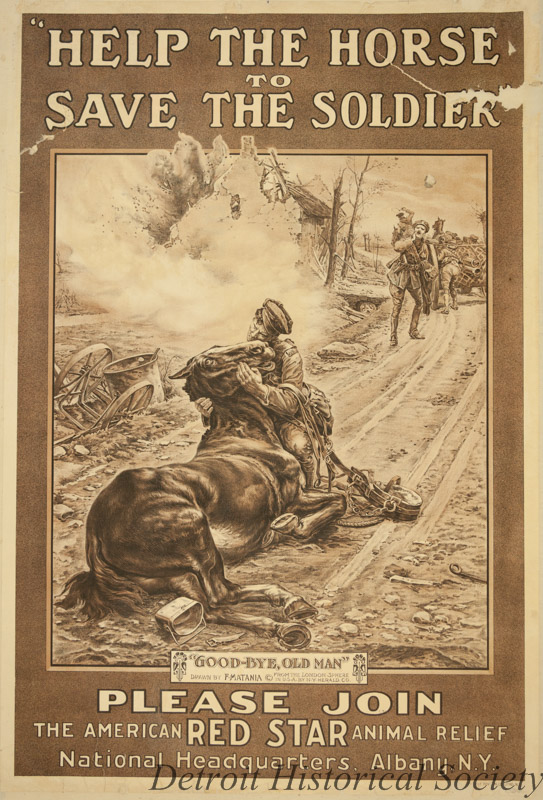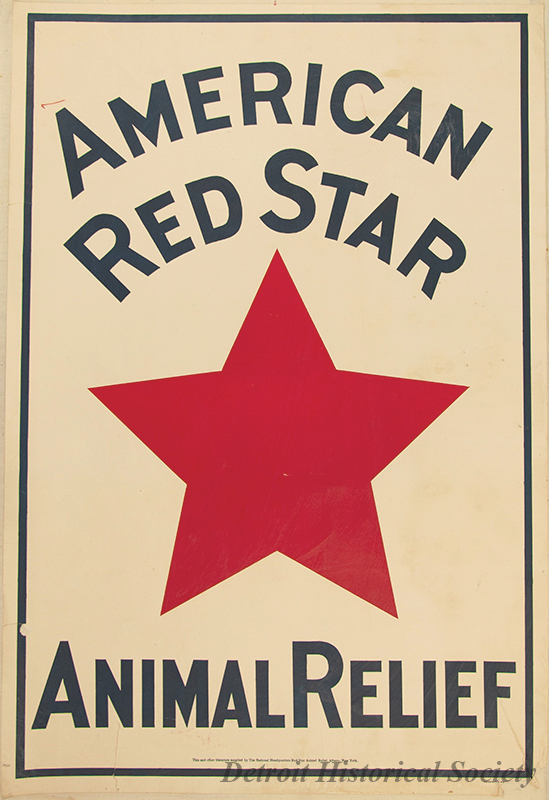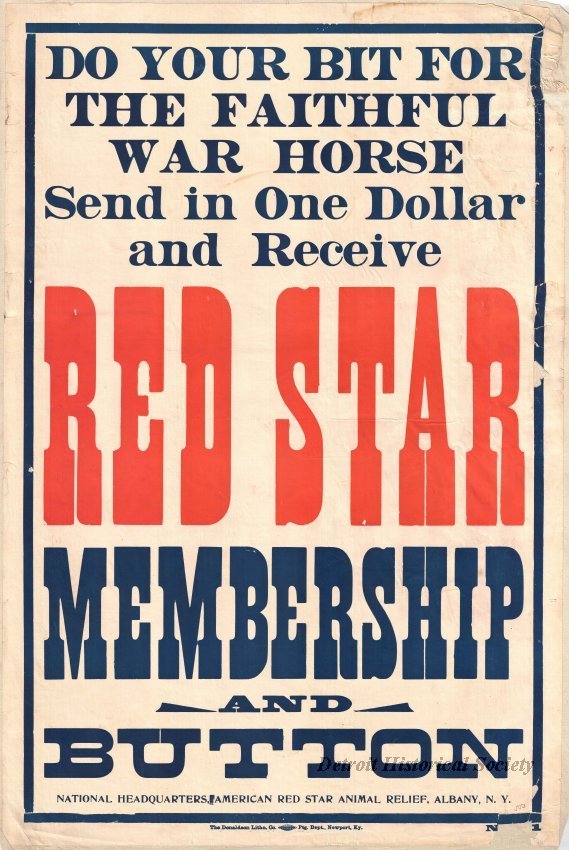Red Star: Help the Horse to Save the Soldier
World War I was an unprecedented conflict. At the intersection of dramatic new weapons of war, a shrinking globe, automobiles, aviation, and more hallmarks of innovation, the world was changing – for both soldier and civilian. Before the emergence of television or even commercial radio, governments needed a widespread and effective method of delivering wartime information to their population. This led to many countries using the already popular advertising medium of posters to broadcast messages during the war. These articles of propaganda, both beautiful works of art and powerful methods of persuasion, are still admired years later for their historic, artistic and cultural significance. Popular and unknown illustrators created posters that reflected various themes. Some posters advertised the importance of saving food by maintaining a family garden, while others solicited contributions to wartime funds like the Liberty Loan. Many aimed to recruit soldiers and remind Americans why they were involved in a foreign war, calling forth images of atrocities taking place overseas.
 James Montgomery Flagg, creator of this poster, was also responsible for the iconic “I Want You” poster, cementing the depiction of Uncle Sam using himself as a model.
James Montgomery Flagg, creator of this poster, was also responsible for the iconic “I Want You” poster, cementing the depiction of Uncle Sam using himself as a model.
A series of posters within the Detroit Historical Society’s collections promote an often-overlooked support group from World War I, the American Red Star Animal Relief. A division of the American Humane Association, the Red Star provided aid to horses serving in the war. The group was formed in 1916, when U.S. Secretary of War Newton D. Baker invited American Humane to assist horses in the same manner that the American Red Cross assisted soldiers. Despite not yet in the war, the United States had been shipping beasts of burden overseas in mass quantities to be used by allied nations. Red Star provided assistance in the form of bandages, medicines, ambulances, and personnel including volunteer veterinarians, stable hands, and blacksmiths. Red Star cared for more than 68,000 injured and sick horses every month. World War I was one of the last major conflicts to involve horses in a serious way, particularly in a combat capacity. Until this point, mounted cavalry was a critical piece of any military presence, but this declined as the war progressed. The development of trench warfare, the expanded use of barbed wire, and machine guns made horses much less viable in combat roles, even a liability. Cavalry operations all but disappeared on the Western Front. Shock tactics that would have employed cavalry shifted to use tanks instead. Despite their diminished combat roles, horses and mules were indispensable for transportation of munitions, food, artillery guns, and much more. They were far more adept than automobiles at traversing difficult terrain like deep mud. This made them valuable and reliable for reconnaissance and delivering messages. It is estimated that several million horses died during World War I. Much like human casualties, the majority came from disease or accident, with only about a quarter of all horses dying in combat. However, horses made large targets for artillery and machine gun fire and were sometimes deliberately aimed for. During the Battle of Verdun, 7,000 horses were killed in one day from artillery fire. The loss of horses over the course of the war was so severe that a “horse shortage” manifested. Requests for new mounts became increasingly difficult to fulfill, making the Red Star’s job of getting wounded horses back into action all the more important.
 "Taking the Guns" by Harry Bennett, Henry Ford’s infamous strongman, depicts a World War I scene with multiple facets indicative of the war, including the place of the horse.
"Taking the Guns" by Harry Bennett, Henry Ford’s infamous strongman, depicts a World War I scene with multiple facets indicative of the war, including the place of the horse.
 Horses were susceptible to the same perils that faced the soldier, beyond the threat of gunfire. This included diseases like equine influenza, complications from toxic gasses, and even shell shock. Starvation was a real concern for horses, especially later in the war when fodder often wasn’t readily available. Horses and soldiers often shared powerful bonds with one another. Morale tended to be higher where horses were present. The loss of a horse could leave a soldier emotionally scarred, and parting with a horse at the end of the war was also an often-heartbreaking affair. The Red Star still exists 100 years later as the Red Star Rescue Team, which aids animals affected by natural and man-made disasters of all kinds, as well as incidents of animal cruelty. Throughout their long history, Red Star volunteers have worked tirelessly to save animals during catastrophes including the eruption of Mount St. Helens, Hurricane Katrina, and the events of September 11, 2001. The group also trains animals for therapy capacities to assist people who are dealing with trauma. The American Humane Association provides many services that aid in the welfare of animals beyond Red Star. Their “Be Kind to Animals Week,” founded in 1914, is reportedly the oldest commemorative week in the United States. American Humane provides the specialists that ensure “no animal was harmed” when filming movies and television. For a century, the association has been advocating for the welfare of animals, and children, and has made a marked difference on how we interact with pets, farm animals, and even animals in the armed forces. These posters, while perhaps not as well-known as other examples of the era, remind us of an unfortunate aspect of war. With the centenary of the WWI Armistice on November 11, 2018, perhaps we can take a moment not only to appreciate the soldiers who fell in the conflict, but also the animals who had no choice in their sacrifice.
Horses were susceptible to the same perils that faced the soldier, beyond the threat of gunfire. This included diseases like equine influenza, complications from toxic gasses, and even shell shock. Starvation was a real concern for horses, especially later in the war when fodder often wasn’t readily available. Horses and soldiers often shared powerful bonds with one another. Morale tended to be higher where horses were present. The loss of a horse could leave a soldier emotionally scarred, and parting with a horse at the end of the war was also an often-heartbreaking affair. The Red Star still exists 100 years later as the Red Star Rescue Team, which aids animals affected by natural and man-made disasters of all kinds, as well as incidents of animal cruelty. Throughout their long history, Red Star volunteers have worked tirelessly to save animals during catastrophes including the eruption of Mount St. Helens, Hurricane Katrina, and the events of September 11, 2001. The group also trains animals for therapy capacities to assist people who are dealing with trauma. The American Humane Association provides many services that aid in the welfare of animals beyond Red Star. Their “Be Kind to Animals Week,” founded in 1914, is reportedly the oldest commemorative week in the United States. American Humane provides the specialists that ensure “no animal was harmed” when filming movies and television. For a century, the association has been advocating for the welfare of animals, and children, and has made a marked difference on how we interact with pets, farm animals, and even animals in the armed forces. These posters, while perhaps not as well-known as other examples of the era, remind us of an unfortunate aspect of war. With the centenary of the WWI Armistice on November 11, 2018, perhaps we can take a moment not only to appreciate the soldiers who fell in the conflict, but also the animals who had no choice in their sacrifice. 



